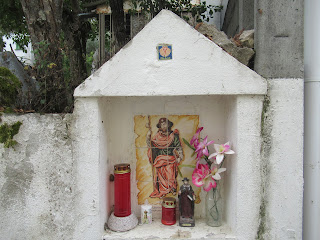El Camino Portuguese
Ansiao to Condeixo a Nova
I had had a bad night for several reasons, one was that I had had a np in the afternoon and so wasn't really tired. There was a mosquito in the room which buzzed around my ears for ages and refused to back off
Lastly there was a downpour outside with rain beating on the windows, amplified by pounding the tin roofs and I don't like walking in the rain which was forecast at over 50% probability to last all day. I was up early to change the schedule to a bus of s taxi but the thunderstorm kept interrupting the internet.
I was having breakfast when everything went quiet. The rain stopped pounding on roofs and windows, the wind calmed and the water rushing down drain pipes eased off to nothing. Somebody up there was looking after pilgrims. I ditched the alternative plans and started walking.
Both EL Camino Portuguese and the Fatima trail follow the sane route out of Lisbon until Santarem and then split. Now one of the alternative Fatima trails from Coimbra to the north uses part of the El Camino Portuguese to go in the opposite direction so the arrows point in opposing directions.There is a perfectly good road, the N348/7 that runs along the flat bottom of the valley but El Camino has to go over the top or the shoulder of every hill. A pilgrim's route in not meant to be easy, otherwise its just a long walk. We had already climbed up to Netos, down to cross the road and up to Alvorge, down to cross the road and over the shoulder of this hill. The path is visible to the left as it snakes its way up to the shoulder of the hill.
It has been a while since I saw or heard these two stroke motor mower type engines.
One of the few hills that the trail doesn't go up and down.
A local wind mill, the type that Don Quixote (admittedly he was Spanish but the style is seen through the peninsula) might have had a tilt at.
A shrine dedicated to St James in Fonte Coberta.








No comments:
Post a Comment